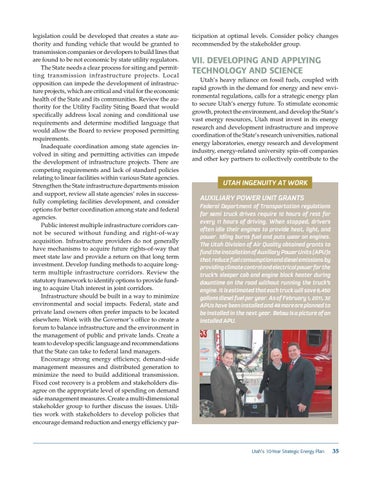legislation could be developed that creates a state authority and funding vehicle that would be granted to transmission companies or developers to build lines that are found to be not economic by state utility regulators. The State needs a clear process for siting and permitting transmission infrastructure projects. Local opposition can impede the development of infrastructure projects, which are critical and vital for the economic health of the State and its communities. Review the authority for the Utility Facility Siting Board that would specifically address local zoning and conditional use requirements and determine modified language that would allow the Board to review proposed permitting requirements. Inadequate coordination among state agencies involved in siting and permitting activities can impede the development of infrastructure projects. There are competing requirements and lack of standard policies relating to linear facilities within various State agencies. Strengthen the State infrastructure departments mission and support, review all state agencies’ roles in successfully completing facilities development, and consider options for better coordination among state and federal agencies. Public interest multiple infrastructure corridors cannot be secured without funding and right-of-way acquisition. Infrastructure providers do not generally have mechanisms to acquire future rights-of-way that meet state law and provide a return on that long term investment. Develop funding methods to acquire longterm multiple infrastructure corridors. Review the statutory framework to identify options to provide funding to acquire Utah interest in joint corridors. Infrastructure should be built in a way to minimize environmental and social impacts. Federal, state and private land owners often prefer impacts to be located elsewhere. Work with the Governor’s office to create a forum to balance infrastructure and the environment in the management of public and private lands. Create a team to develop specific language and recommendations that the State can take to federal land managers. Encourage strong energy efficiency, demand-side management measures and distributed generation to minimize the need to build additional transmission. Fixed cost recovery is a problem and stakeholders disagree on the appropriate level of spending on demand side management measures. Create a multi-dimensional stakeholder group to further discuss the issues. Utilities work with stakeholders to develop policies that encourage demand reduction and energy efficiency par-
ticipation at optimal levels. Consider policy changes recommended by the stakeholder group.
VII. DEVELOPING AND APPLYING TECHNOLOGY AND SCIENCE Utah’s heavy reliance on fossil fuels, coupled with rapid growth in the demand for energy and new environmental regulations, calls for a strategic energy plan to secure Utah’s energy future. To stimulate economic growth, protect the environment, and develop the State’s vast energy resources, Utah must invest in its energy research and development infrastructure and improve coordination of the State’s research universities, national energy laboratories, energy research and development industry, energy-related university spin-off companies and other key partners to collectively contribute to the
UTAH INGENUITY AT WORK AUXILIARY POWER UNIT GRANTS Federal Department of Transportation regulations for semi truck drives require 10 hours of rest for every 11 hours of driving. When stopped, drivers often idle their engines to provide heat, light, and power. Idling burns fuel and puts wear on engines. The Utah Division of Air Quality obtained grants to fund the installation of Auxiliary Power Units (APU)s that reduce fuel consumption and diesel emissions by providing climate control and electrical power for the truck’s sleeper cab and engine block heater during downtime on the road without running the truck’s engine. It is estimated that each truck will save 6,450 gallons diesel fuel per year. As of February 1, 2011, 32 APUs have been installed and 49 more are planned to be installed in the next year. Below is a picture of an installed APU.
Utah’s 10-Year Strategic Energy Plan
35








